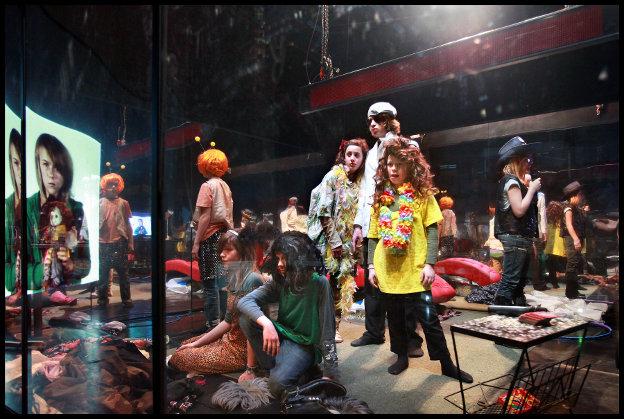In Before Your Very Eyes, for the first time in their seventeen year history, Gob Squad do not themselves appear onstage, but instead direct a group of 8-14 year-olds who they first met more than three years ago, using texts developed during improvisation and in collaboration with the performers. Before Your Very Eyes is the final part of the CAMPO trilogy of theatre works made with children for adult audiences. (The first part was Josse De Pauw’s üBUNG, and the second Tim Etchells’ That Night Follows Day).
Ladies and Gentlemen!
Gob Squad proudly present
a live show with real children.
A rare and magnificent
opportunity to witness seven lives
lived in fast forward…
Before Your Very Eyes!
On stage is a room bordered on all four sides by one-way glass, the rear wall mirrored and reflective. Inside this room are children: a girl on a two-seat sofa plaits another girl’s hair, a boy lies on the floor reading, three young people at a table play a card game while a TV showing a cartoon goes unobserved. The ambience is silent, like looking into an aquarium; the children are relaxing. Are they waiting? Filling time? They appear unselfconscious as they play, chat, chill. They’re comfortable. There are seven of them. We, the audience, feel uncomfortable with this imposed voyeurism.
Lights on the audience go down, lights come up brighter in the ‘aquarium’… we hear their voices. Belgian? Flemish? A child is blindfolded, they continue to play. A girl takes a microphone and states, ‘we are all speeding toward death, yet here we are alive’. There is wild dancing to a Queen track, Don’t Stop Me Now. All seven youngsters are introduced. Then an omnipotent voice commands: ‘Get on with it – GROW! Grow up!’
The children begin to dress up as they look toward their future adult selves, first becoming 19 year-olds. A screen shows prerecorded video of them as young boys and girls, talking of what they like and what they can do and what they’re good at, and their teenage selves look on with ridicule and embarrassment… There are questions from their younger selves about puberty, and from their adult selves scenes of sex on sofas and cigarettes and stuffing bras with tissue. They fast forward to middle-aged people, improvising party scenes, posing and composing their caricatures, projections of who they will be, reflections on their desires and failed expectations. What they can do becomes what might have been, acceptance of one’s lot – we witness these changes before our very eyes.
Adding wigs and glasses they become elderly. ‘I don’t care how I die, as we’re all going to die in a way we don’t want to.’ They want to get to the best bit, the dying scene… and there follows the most extraordinary death scene: they run on the spot, fast-forward, cartoon style, with grey wigs on, cushions up the jumper to give them big bellies, and then they drop off one by one, collapsing, dying by the wayside, in awkward positions, until just one, in her housecoat, is left running alone on the spot… ‘How does it feel to be the last one left?’ Asks the kindly omnipotent voice.
At times I don’t know if I’m in tears laughing or crying. It’s comedic, it’s awful, it’s tragic, yet it’s daft, it’s appalling – it is how it is, and how it is has something to do with the children play-acting being adults. In their portrayal of adults you can see an aspect of themselves as the adult they will be, bound with the adult they’re portraying; in that adult you can see the seed, the core of that adult as a child, can see that something is carried through, something that grows and ages and disintegrates along with all those hopes and dreams, and can see as well that there is something near-eternal that doesn’t age yet is cut to the quick at that moment of death, extinguished, in a dead person, a twisted corpse lying in an undignified position on the floor…
It’s been kids playing, acting stuff out in wonky wigs and drawn-on moustaches, yet it mangles your emotions right up. For the curtain call, the youngsters rapidly remove their wigs and make up and, stepping out from their glass-walled confine to heartfelt applause, come to stand in front of us for the first time, and there they are, kids, surprisingly young and fresh-faced. They’ve taken us on such a journey, we’re awash with astonishment.


